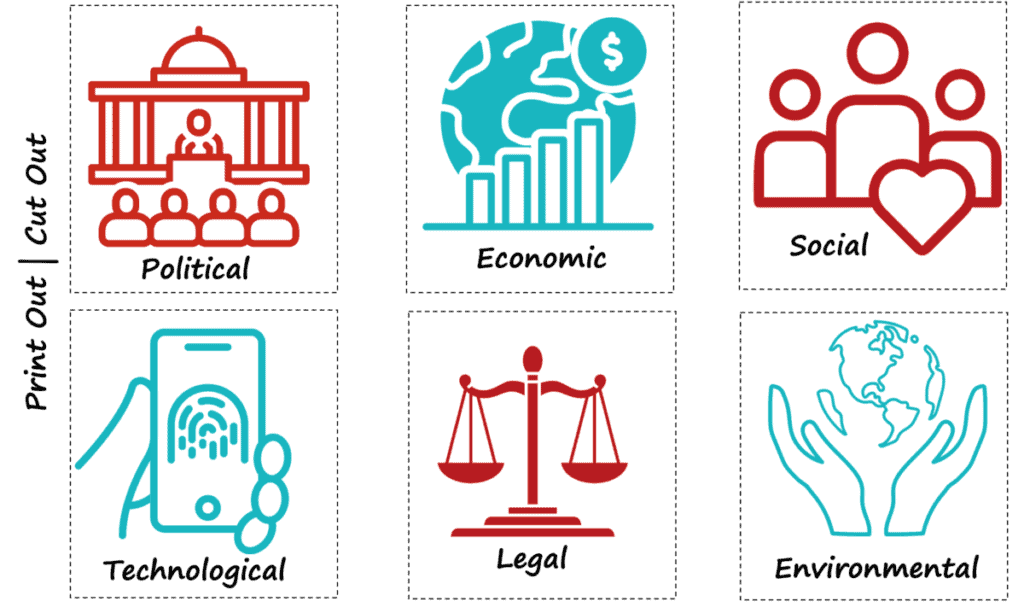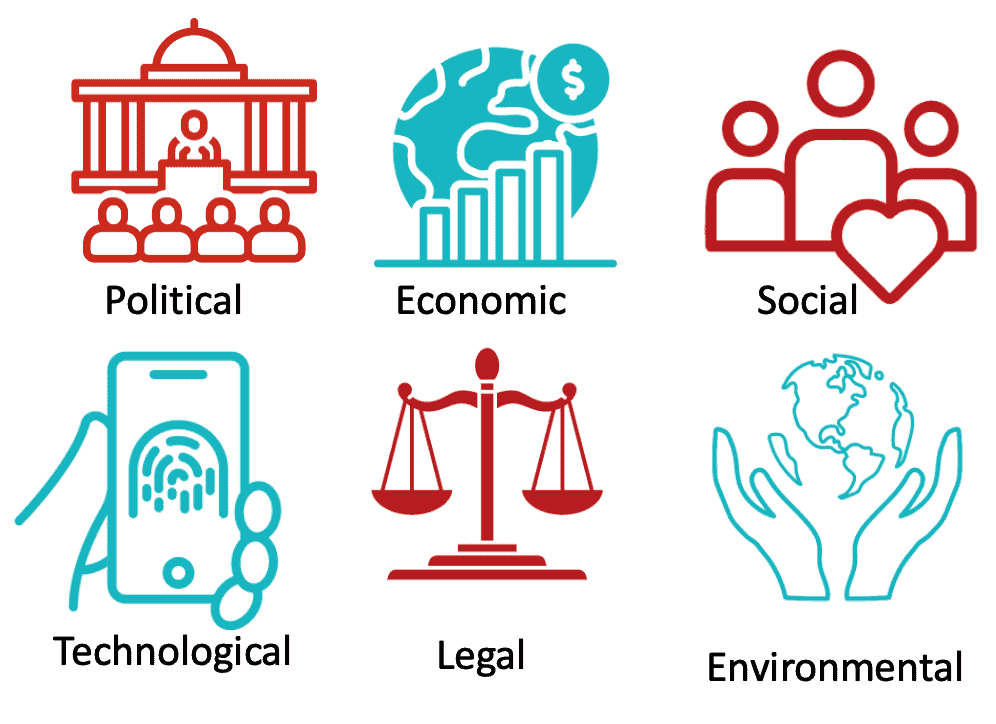Business success largely depends on the strategy, organisational structure, employment policies, and other internal factors that the organisation has full control of and can work on their improvement to enhance its performance.
However, the growth or decline of business will also depend on external factors that are out of the organisation’s reach, so it can’t control them.
This is not necessarily a bad thing as, in addition to causing significant threats, the changes in the business environment can also create meaningful opportunities for businesses to grow and develop.
For example, new technologies may create an opportunity to improve the production process or help the company reach new customers, while shifts in government policies can open up previously inaccessible markets. On the other hand, these external movements can have a negative effect and change the environment for the worse, shrinking the market, creating more competition, or increasing interest rates.
So, not everything will be in the hands of business. Still, what businesses can do is explore and analyse those external factors, so they can understand how and why that happens.
Understanding the environment a business operates in helps an organisation make the best decisions for the future, gain valuable insight into the big picture forces that are in play in a particular industry, and identify the specific opportunities and threats that may have a positive or negative impact on the company’s operation.
One of the most powerful an organisation can use to make sense of these external factors and adapt to the current and future business environment is the PESTLE analysis technique.
Table of Contents
What is PESTLE Analysis?
PESTLE analysis is a technique
PESTLE analysis involves tracking the changes in the business environment to discover facts about external factors that can help the organisation evaluate risks, minimise potential threats, and maximise opportunities. This way, the organisation can understand the direction in which the environment is changing and adapt to operate with those changes instead of going against them.
When done properly, PESTLE analysis can help the organisation predict which projects are destined to fail and avoid investing significant resources into their development. Also, this method can provide valuable insight into new markets, allowing organisations to base their expansion strategy on objective facts instead of diving head-first into new and unexplored ventures.
Another significant value of the PESTLE analysis is that it can serve to prepare the foundation for implementing the SWOT analysis. While the SWOT method
What are the Six Elements of PESTLE Analysis?
PESTLE is actually an acronym representing the six major categories of factors this technique explores: Political, Economic, Social, Technological, Legal, and Environmental factors.
To fully use all the benefits of the PESTLE analysis, it’s necessary to gain an in-depth understanding of each of these factors. The significance of various external factors may vary and different factors can be more or less important depending on the industry and specificities of the particular market.

Political Factors
This group of factors includes those that are driven by the actions of the government and its policies. This may also include the actions of other regulatory bodies such as trade unions. The political factors indicate to what extent the government can influence an industry or the operations of a particular company.
New tax reforms, for example, significantly change the way a company generates revenue and shift the balance of power in the industry. When performing an analysis of the political factors, the organisation should identify which government policies, political groups, or regulatory bodies can be beneficial or detrimental to the company’s success.
In addition, the analysis should provide information on whether the political environment is stable or vulnerable to frequent changes.
Examples of political factors include government policies, corporate taxation and other fiscal initiatives, trade agreements and disputes, corruption, state’s foreign policy, the level of customer, labor, and environmental protection, competition and antitrust regulations, and others.
Economic Factors
Economic factors relate to broader economic forces that influence business operations. These factors determine the national and global economy which significantly impacts the organisation both in the short and long term.
A good example is a rise in the inflation rates which is likely to force the company to reevaluate the pricing of their products and determine how to adjust their prices according to the purchasing power of their customers. Economic factors are almost always of a financial nature. Because of this, some analysts tend to put too much emphasis on economic factors compared to other categories as they’re easier to comprehend and quantify.
Examples of economic factors include general economic trends, interest rates, inflation, employment rates, industry growth, exchange rates, seasonal factors, labor costs, raw material costs, and many others.
Social Factors
This category of external factors indicates the social aspect of the market and helps assess the determinants that create the social environment. They’re harder to quantify than some of the other factors, such as economics, and are not as tangible which is why they sometimes get overlooked. However, they have a huge impact both on the industry trends and individual companies.
For example, the shift toward a healthier lifestyle has completely changed several different markets, including the food and fitness industry. Information provided by the analysis of social factors also plays a key role in how companies create their marketing strategy.
Examples of social factors include demographic considerations and population growth, family size and structure, immigration and emigration, lifestyle trends, consumer belief and their attitude toward all aspects of modern life, cultural taboos, and others.
Technological Factors
Technological factors are the element of PESTLE analysis that relates to how technology impacts the way an organisation produces, distributes, and communicates its products and services. As technology is ever-present in our lives and is constantly changing and evolving, it’s very important that analysts pay particular attention to these actors because neglecting them is the shortest route to the overall failure of the organisation.
The emergence of new technologies can push the entire industry forward, but also have a devastating effect on those who fail to keep up with the changes. A great example is the emergence of ride-sharing services such as Uber or Lift which completely revolutionised the transportation industry.
Examples of technological factors include tech and communication infrastructure, automation, the level of consumer access to new technologies, the costs of maintaining the R&D departments, cyber security, tech legislation, and many others.
Legal Factors
Legal factors emerge as a result of changes in the legislative environment and have a very broad impact, influencing global and national economies, entire industries and specific sectors, and individual businesses. A certain change in regulation can help a company move forward or hinder its development.
This is why organisations must keep up to date with all legislative and regulatory changes and find ways to adjust to new legislation, especially in heavily-regulated industries, such as finance.
Sometimes, the high level of regulation in industries such as food production can work in favour of businesses as it significantly raises the bar for the emergence of new companies, thus creating a less competitive environment.
Environmental Factors
Environmental factors are those that play a role in how the surrounding environment and ecological aspects influence business operations. For many industries, this is the most significant category of external factors. For example, in agriculture or tourism, the entire business model and strategy are dependent on the impact of the environmental forces on natural resources and surrounding.
Other industries are also starting to pay more attention to environmental factors and discovering how changes in the environment can create new opportunities or pose material risks or threats for organisations.
Examples of environmental factors include weather, the impact of climate change, carbon footprint, increased frequency of extreme weather events, pollution laws, endangered species, recycling and waste management policies, and others.
Advantages and Disadvantages of PESTLE Analysis
Like most of the other analysis techniques, PESTLE can bring a lot of good to organisations and help them thrive and stand out in the market.
However, there are some downsides, too, and in certain circumstances, other techniques may provide better results. Below is a brief rundown of the major advantages and disadvantages of using PESTLE analysis as a method for studying external factors.
Advantages of PESTLE Analysis
The following are the advantages of PESTLE analysis:
- Relatively simple and easy-to-use analysis framework
- Delivers an understanding of broader forces in the company’s environment
- Fosters external and strategic thinking within the organisation
- It’s a very cost-efficient method, as time and effort are commonly the only investments needed
- Helps organisations identify future opportunities and develop a strategy on how to exploit them
- Helps organisations prepare for potential threats and minimise risks
Disadvantages of PESTLE Analysis
The following are the disadvantages of PESTLE analysis:
- Can be time-consuming
- There’s a risk of oversimplifying the data and using insufficient information for strategic planning
- Needs to be performed on a regular basis, as repetition is the only way to keep up with business environment changes
PESTLE Analysis Template
A PESTLE Analysis template is included as 1 of the 50 templates in the project template bundle.
The PESTLE Analysis template should be used when you and your team want to evaluate your organisation, department, project or product in terms of factors impacting you from the external environment. The factors you will assess are categorised into the following: Political, Economic, Social, Technological, Legal and Environmental.
The PESTLE Analysis template is available in various formats including google slides, PowerPoint, MIRO.

